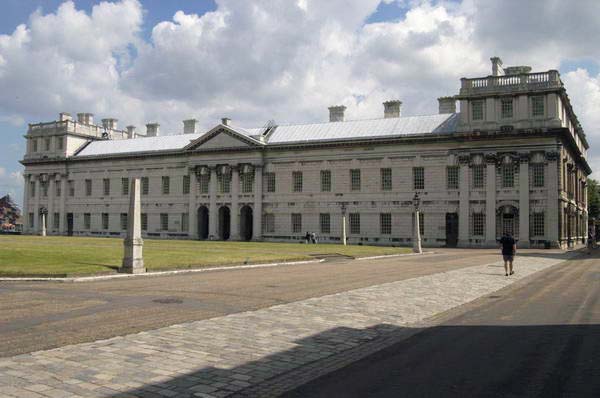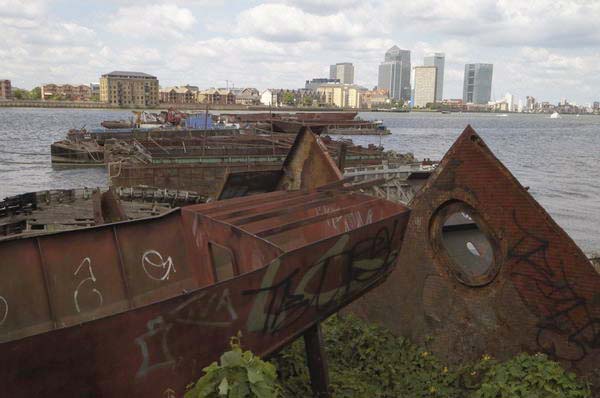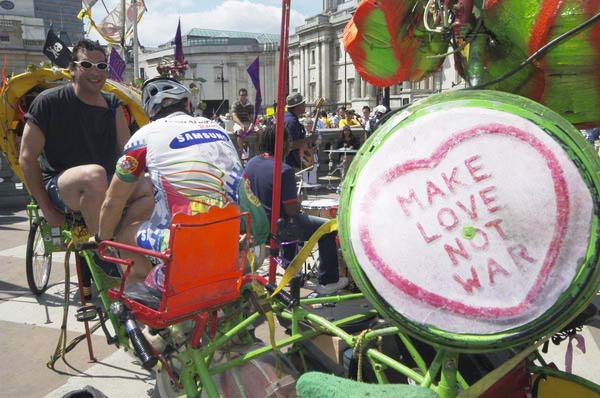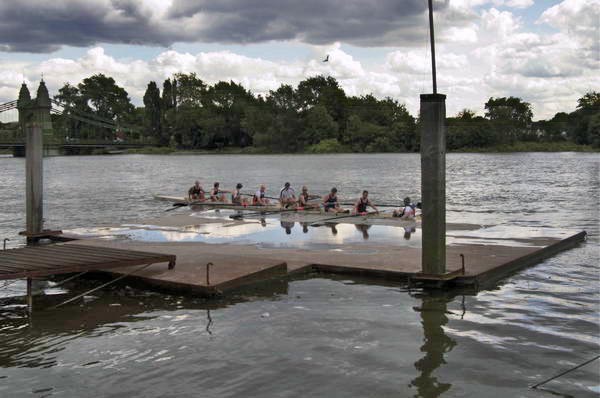The cannabis march had to be postponed at the start of
may, when heavy rain caused one of London's lost rivers, the effra, to
put in an appearance in brockwell park. numbers were down for the start
of the march which ambled its way down from kennington park for the
festival, but things picked up considerably on the way through brixton.
in the festival things started to get distinctly mellow, with some great
music, including one of the real trumpet legends of popular music and
some well-known rap. lesson to kingston green fair were the poets and
politicos - including jenny jones for the greens and a beatifically
stoned howard marks - who got a good audience between the musical acts.
more pictures
i was sorry to have to leave before the end of what was a very
pleasant event, showing that as a cultural drug, cannabis has many
advantages over alcohol (though there was also plenty of that in
evidence, and i had some of the nicest cider from hereford i've drunk
in a while, that fully deserved its gold medal status.) perhaps the
main forces against legalisation are now from the organisations
profiting from the drug traffic and also the alchol business. a
grow-it-yourself revolution could make big dents in many corporate
profits. but it was off to kensington for a very pleasant evening with
friends and a good italian meal (none of us had pizza!)
i've a great respect for the sikhs whose religion puts the values
that society should value at its centre. they got a very raw deal when
we carved up the indian subcontinent between hindus and muslims giving
them independence, partitioning the largely sikh panjab leading to
bloody ethnic cleansing and submission. the indian government has
treated sikhs worse than under british rule, not even conceding
recognition of panjabi as the official language of the panjab until
1966.
operation bluestar, starting at the end of may 1984, was the first
large-scale military operation by 150,000 indian troops against the
panjab. on 4 june, indira gandhi ordered the army to invade the golden
temple in amritsar. it was a significant date, during the celebration
of the 5th sikh guru, guru arjun dev, who built the temple and was the
first sikh guru to be martyred, in 1606. reports in western papers at
the time talked about large numbers of women and children being gunned
down and the army preventing aid works from giving medical aid or even
water to the injured and dying. reliable reports put the deaths from
the incident at around 4000
repression continued in the panjab, but a new peak of violence was
reached in november of the same year. Following the assassination of
indira gandhi by her two sikh bodyguards, the government and police
encouraged and orchestrated four days of mob violence which resulted
in the massacre of many thousands of sikhs across india.
in the following years, india turned the panjab into a police state,
with thousands of arrests and disappearances of sikhs. the police set
up roughly fifty cremation grounds across the state; an inquiry into
just three of these showed that at these sites alone, around a
thousand sikhs had been disposed of at these. Thousands of other
bodies were just dumped into rivers and canals. some of those
investigating these events have themselves disappeared. few official
inverstigations have been started and even these have made little or
no progress.
many sikhs see the only way forward as an independent state of
khalistan, and a declaration to this effect was made in 1986, with a
countil of khalistan being set up the following year.
sikhs want truth and justice. they want the world to know about the
'sikh holocaust' at indian hands and they want those who perpetrated
it brough to justice. it is hard to understand why such genocide in
india has received relatively little attention worldwide.
more pictures
carshalton carnival is one of the livelier of such events still
taking place in greater london. as well as the procession there is
also a large fair in carshalton park. it is in many respects a very
local event, with many local groups taking part. the weather stayed
fine, several thousand people enjoyed themselves, and doubtless the
event made money for the various charities supported.
more pictures
on my way back i stopped off in merton, to take a look at the open
day at the ruins of the chapter house of merton priory. founded in
1114, it became one of the most important medeival abbeys in england,
more important than westminster or canterbury. the earliest written
english laws are the eleven 'statutes of merton' of 1236, written
there because westminster was flooded. merton college, founded by
walter de Merton, was one of three that started oxford university in
the 1260s.
henry viii's marital problems led to the dismantling of the abbey in
1538, with much of its stones coming in handy to build a new pad for
anne boleyn down the road at nonsuch palace in cheam. the site itself
stayed pretty derelict, but was still known as merton abbey.
excavations from 1914-20 established the floor plans of the site,
which is a scheduled ancient monument.
in 1959 a garden was created on the site of the main altar of the
church and 'given in perpetuity' to the people of merton. this now
lies several feet below the surface of the car park of the
'savacentre'. most of the rest of the site of the huge church is also
preserved below the tarmac, with a little still present beneath the
edge of the supermarket. the ruins of the chapter house is in an
enclosed area under the main dual carriageway of merantum way. most of
the rest of the abbey buildings were to the south of this, and the
site has recently been excavated before it is completely destroyed by
new development.
part of the site was developed as a calico printing works in 1724,
using water and power from the river wandle. the site has a large
undershot waterwheel, around two hundred years old and know in use by
a potter. arthur liberty used littler's print works here to print the
fabrics for his regent stree store, taking over the site completely in
1904 and using parts of it until 1977. an even more famous name,
william morris, signed a lease for a site by the river in the north of
merton abbey in 1881, and morris & co produced decorated glass,
printing fabrics and other goods there, closing in 1940; a plaque on
the site gives some details.
the area also has a place in railway history, with the world's first
public railway, the horse-drawn surrey iron railway beside the river
wandle opening in 1804, taking goods down to the thames at wandsworth.
more pictures
sunday i started at greenwich, where i took at walk around the
grounds of the former royal naval college, now more open to the public
as greenwich university; certainly a fine and historic site. as there
were no train services to greenwich beacuse of engineering work on the
line i decided to walk along the river to north greenwich. some of the
old riverside has gone, with a few new blocks of flats replacing
wharfs, and many sites now either unused or relying entirely on road
transport. the riverside path has been tidied up, fenced in and
homogenised, but enough is left for it to remain exhilirating. you no
longer need to look out for the overhead cranes spilling gravel or
lorries maing their way across the route, or to pick your way
carefully between the container carriers, and the only people in view
on a sunday are the occasional walkers and more numerous cyclists out
like me to enjoy the weather.
the tube took me to trafalgar square for the first 'bikefest' to be
held there. i was flabbergasted to find the first notice i saw was one
telling me that bikes were not allowed on the square. how can you have
a bike festival and ban bikes? it was certainly a warning that this
was not to be a serious bike event, and i longed for critical mass to
sweep in and stick their fingers up at authority. perhaps next time?
it was a show without a centre, though one or two mildly interesting
fringes.
good to see rinky-dink again, though more than disappointing that
instead of hearing their music they were simply employed to back a
rather turgid group and kept stationery in a corner of the terrace.
why not have them wandering around the square dispensing their own
melodious beat that kept us marching towards aldermaston in april?
weapons of sound were interesting to look at, but the music lacked the
promised funk.
team extreme were great on the half pipe. like all such displays it
amazed me what they could do, but i end up feeling that this is not
what cycling is about. i was glad of the safety barriers when one of
the guys landed badly after a terrifying stunt and left his bike to
skid across the surface and crash into the barrier in front of me. it
looked and sounded bad but to all our relief he got up smiling and
walked away.
then i met joe with his unicycle. he'd already been hassled by the
'heritage wardens' (ken's ss) for riding it in the square. he'd come
with his mountain model and decided to give it a ride in the
fountains. a couple of minutes fun and a little entertainment for
those in the square was too much for the wardens to allow, and he was
soon being told to get out. a pity, since those big steps down from
the terrace to the square would have been great for a unicyclist and
added a little much needed zest.
more pictures
meanwhile in leicester square we were still fighting ww2, with a
latter-day vera lynn entertaining some. we fought for europe, and now
are celebrating this on the same day as the results came out with so
many rejecting it. in many ways war in the west end seemed to me a sad
event, and there were no great signs those taking part were having a
good time. relatively few had made much of an effort to dress the
part, though there were three young ladies in the kind of clothes that
very much made me think of my own mother and the other ladies of her
generation when i was on parade in my perambulator. actually more the
other ladies given my mother's fashion sense which i seem to have
inherited. am i the only person to have been blackballed from a
photography club on sartorial grounds?
more pictures
home of tennis and the wombles, wimbledon always strikes me as an
alien implant in london by some civilisation with a time machine, a
sense of humour and a very fat wallet. i dropped in to the village
fair just to see it still existed.
half an hour later i was back in the real world. where companies make
off with the pension funds leaving people who have paid in to schemes
for years with no pensions. where other creditors come before pension
holders when companies go bust.
where millions of lower paid workers now have no employment pension
rights at all. where women have always been treated unfairly in many
respects. where government has worsened conditions for civil servants,
teachers and others. As TUC General Secretary Brendan Barber says
"Those who used to have good pensions now have poor pensions. Those
who used to have poor pensions, now have no pension."
more pictures
on the way home i went for a walk by the river in hammersmith,
another area of london strongly associated with william morris. the
funivall sculling club here was established in 1896 as the hammersmith
sculling club for girls - the world's first women's rowing club - by
dr frederick furnivall; it went unisex in 1901. furnival had earlier
championed rowing for working men. he served as the model for the
water rat in 'wind in the willows', as well as being involved with the
preparation of the oxford english dictionary.
more pictures
sunday the streets of london were alive to the sound of hare krsna,
hare krsna, krsna krsna, hare hare, hare rama, hare rama, rama rama,
hare hare.... as several thousand supporters pulled three 40ft tall
decorated wooden chariots from hyde park to trafalgar square to
celebrate the indian festival of rathayatra - the carnival of
chariots. an extension from hinduism, krishna consciousness isn't my
thing, involving abstinence from alcohol, coffee, meat, onions,
mushrooms and sex except for the purposes of procreation. the movement
has come a long way from its roots in new york's lower east side in
the flower-power years, but still seems a part of those times. all
respect to the sincerity, honesty and friendliness of these people,
and it was a great show, the biggest in london yet, but a few hours of
being kind and good and aiming for perfection was enough to last me
the year.
more pictures
most of the new riverside developments along the thames have been
pretty dire. although the planning process has opened up stretches of
riverside walk, it has also meant less and less of it is worth
walking, marred by bland investment-maximising flats. possibly the
latest at putney are better than many. i'd like to see a planning
process that insisted on architectural excellence in key high-profile
sites, with the developers compelled to go to public competition over
the designs.
wandsworth bridge at least adds a little colour to the river,
although its 1930s design seems rather utilitarian. there are still
signs of the working river around.
i've tried to avoid the flags, most of which don't look like the
traditional cross of st george to me. perhaps we can forget about them
now?
more pictures
wimbledon can doubtless be blamed for the rain, and it fell
relentlessly if not too heavily all saturday morning as we waited
around in brixton for the precursor of the next example of sporting
madness. however it was an occasion for a little fun, with music and
some attractive samba dancers from quilombo do samba, some athletic
capoeira (a latin american version of morris dancing?) from abada
capoeira and a little carnival from south connections and angell town
community group (and some drumming from Sandy Lamb) lifting the
greyness.
eventually the caravan arrived, although it was actually a black
taxi, carrying an olympic torch. i gave the photocall a miss so as to
get in position to catch frank bruno ambling down the street with the
torch. across the traffic lights and into brixton high street where he
passed it to a rather attractive davina mccall, apparently a tv
presenter (well, i don't have a tv, so i wouldn't know.)
it all seemed rather a sad non-event (thank goodness i missed the
concert.) the whole olympic bit seems little more than a commercial
event now, publicity for the sponsors. surely its time for a new
olympic movement to pick up the old ideals again?
but in brixton the carnival was bright and colourful and fun for
those taking part and watching.
more pictures
sunday i went out for a little exercise on my bike, over the m25
where they are making more lanes to attract traffic and into thorpe
village, now largely an outpost of the usa, with many of its grandest
old buildings being a part of an american school. then i took a good
look at the sky and covered the 5 or so miles home in record time,
arriving home just catching the first few drops of a torrential storm.
thorpe pictures
monday i was in london for a meeting, but went up a few hours early
to take a walk. at the end of the newly developed 'more london' is a
display of some of the finest photojournalism of our time by tom
stoddart, in the show i-witness, marking 40 years of work by the
disasters emergency commitee.
i walked on across tower bridge and through the tarted up st
katherine's dock - one of london's great missed opportunities - up to
cable street, then past the old music hall to wellclose square and
swedenbourg gardens. here stood ulrica eleonora, the first swedish
church in london, 1728-1911, named after the swedish queen who
abdicated in 1720, and i stopped to eat my lunch in the park close to
the moment erected there in 1960.
from there i wandered a little around whitechapel and bethnal green
before travelling to the city and my meeting.
more pictures
january
february
march
april
may
june
july
august
september
october
november
december
2008
2007
2006
2005
2004
2003
2002
2001
2000
1999
some of my work gets put into nice organised websites.
this isn't meant to be like that, but you can see some
of the rest at
london pictures
londons industrial history
and you can read what I think about photography at
>Re: PHOTO
All pictures on this section of
the site are © Peter Marshall 2004;
to buy prints or for permission to reproduce pictures or to comment
on this site, or for any other questions,
contact
me
your comments may be added to the site
- or not.
Payment may be waived for acceptable non-profit uses.





























